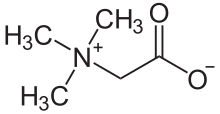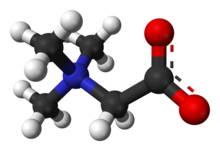Trimethylglycine: Difference between revisions
Updating {{chembox}} (changes to verified and watched fields - updated 'DrugBank_Ref', 'ChEBI_Ref', 'KEGG_Ref') per Chem/Drugbox validation (report errors |
→TMG in agriculture and aquaculture: more detailed information; copy-editing |
||
| Line 69: | Line 69: | ||
==TMG in agriculture and aquaculture== |
==TMG in agriculture and aquaculture== |
||
[[Factory farming|Factory farms]] supplement [[fodder]] with TMG and [[lysine]] to increase livestocks' [[muscle mass]] (and, therefore, "carcass yield", the amount of usable meat). |
|||
The largest use of TMG is as a food supplement in livestock industry. Even though TMG is biosynthesized by all animals in the usual way, TMG is helpful for raising beef and chicken. |
|||
[[ |
[[Salmon farm]]s apply TMG to relieve the osmotic pressure on salmons' cells when workers transfer the fish from freshwater to saltwater.<ref name="Makela">P. Mäkelä "Agro-industrial uses of glycinebetaine" Sugar Tech 2004 Volume 6, 207-212. {{DOI|10.1007/BF02942500}}</ref><ref name="Xue">Xue, M. Xie, S. & Cui Y. (2004). Effect of a feeding stimulant on feeding adaptation of gibel carp ''Carassius auratus gibelio'' (Bloch), fed diets with replacement of fish meal by meat and bone meal. Aquaculture Research, 35: 473-482.</ref> |
||
TMG supplementation decreases the amount of [[adipose tissue]] in pigs; however, research in human subjects has shown no effect on body weight, body composition, or resting energy expenditure.<ref name="pmid12399266">{{cite journal |author=Schwab U, Törrönen A, Toppinen L, ''et al.'' |title=Betaine supplementation decreases plasma homocysteine concentrations but does not affect body weight, body composition, or resting energy expenditure in human subjects |journal=Am. J. Clin. Nutr. |volume=76 |issue=5 |pages=961–7 |year=2002 |month=November |pmid=12399266 |doi= |url=http://www.ajcn.org/cgi/pmidlookup?view=long&pmid=12399266}}</ref> |
|||
TMG is also beneficial to crop yields, e.g. [[maize]] and [[tomato]].<ref name=Makela/> |
|||
==TMG in the human diet== |
==TMG in the human diet== |
||
{| class="wikitable" |
{| class="wikitable" |
||
Revision as of 21:05, 7 October 2011

| |

| |
| Names | |
|---|---|
| IUPAC name
2-trimethylammonioacetate
| |
| Other names
Betaine, TMG, glycine betaine, betaine anhydrous, N,N,N-trimethylglycine
| |
| Identifiers | |
3D model (JSmol)
|
|
| ChEBI | |
| ChEMBL | |
| ChemSpider | |
| ECHA InfoCard | 100.003.174 |
| MeSH | Betaine |
PubChem CID
|
|
| UNII | |
CompTox Dashboard (EPA)
|
|
| |
| |
| Properties | |
| C5H11NO2 | |
| Molar mass | 117.146 |
| Related compounds | |
Except where otherwise noted, data are given for materials in their standard state (at 25 °C [77 °F], 100 kPa).
| |
Trimethylglycine (TMG) is an organic compound that occurs in plants as either glycine betaine or a choline-containing glycine betaine compound. Trimethylglycine was the first betaine discovered by science; originally it was simply called betaine because, in the 19th century, it was discovered in sugar beets.[1] Since then, many other betaines have been discovered, and the more specific name glycine betaine distinguishes this one.
Structure and reactions
Trimethylglycine is an N-trimethylated amino acid. This quaternary ammonium exists as the zwitterion at neutral pH. Strong acids such as hydrochloric acid converts TMG to the salt betaine hydrochloride:
- (CH3)3N+CH2CO2- + HCl → [(CH3)3N+CH2CO2H]+Cl-
Demethylation of TMG gives dimethylglycine. Degradation of TMG yields trimethylamine, the scent of putrifying fish.
Production and biochemical processes
Processing sucrose from sugar beets yields glycine betaine as a byproduct. The value of the TMG rivals that of the sugar content in sugar beets.[2] Glycine betaine production involves chromatagraphic separation.
Biosynthesis
In most organisms, glycine betaine is biosynthesized by oxidation of choline in two steps. The intermediate, betaine aldehyde, is generated by the action of the enzyme mitochondrial choline oxidase (choline dehydrogenase, EC 1.1.99.1). Betaine aldehyde is further oxidised in the mitochondria or cytoplasm to betaine by the enzyme called betaine aldehyde dehydrogenase (EC 1.1.1.8).[3]
Biological function
TMG is an organic osmolyte that occurs in high concentrations (10s of millimolar) in many marine invertebrates, such as crustaceans and molluscs. It serves as a potent appetitive attractant to generalist carnivores such as the predatory sea-slug Pleurobranchaea californica.[4]
TMG is an important cofactor in methylation, a process that occurs in every cell of mammals to synthesize and donate methyl groups (CH3) for other processes in the body. These processes include the synthesis of neurotransmitters such as dopamine, serotonin. Methylation is also required for the biosynthesis of melatonin and the electron transport chain constituent coenzyme Q10.
The major step in the methylation cycle is the remethylation of homocysteine, which can occur via either of two pathways. The major pathway involves the enzyme methionine synthase, which requires vitamin B12 as a cofactor, and also depends indirectly on folate and various other B vitamins. The minor pathway involves betaine-homocysteine methyltransferase and requires TMG as a cofactor. Betaine is thus involved in the synthesis of many biologically important molecules, and may be even more important in situations where the major pathway for the regeneration of methionine from homocysteine has been compromised by genetic polymorphisms.
TMG in agriculture and aquaculture
Factory farms supplement fodder with TMG and lysine to increase livestocks' muscle mass (and, therefore, "carcass yield", the amount of usable meat).
Salmon farms apply TMG to relieve the osmotic pressure on salmons' cells when workers transfer the fish from freshwater to saltwater.[2][5]
TMG supplementation decreases the amount of adipose tissue in pigs; however, research in human subjects has shown no effect on body weight, body composition, or resting energy expenditure.[6]
TMG in the human diet
| Food | TMG per 100g |
|---|---|
| Quinoa | 630 mg |
| Spinach | 577 mg |
| Wheat bran | 360 mg |
| Lamb's quarters | 332 mg |
| Beet | 256 mg |
Nutritional supplement
Although TMG supplementation decreases the amount of adipose tissue in pigs, research on human subjects has shown no effect on body weight, body composition, or resting energy expenditure.[6] The Food and Drug Administration of the United States approved anhydrous trimethylglycine (also known by the brand name Cystadane) for the treatment of homocystinuria, a disease caused by abnormally high homocysteine levels at birth.[7]
TMG supplementation may cause diarrhea, stomach upset, or nausea. Obese persons or those with kidney disease supplementing with TMG, folic acid, and vitamin B6 can experience an increase in total cholesterol levels.[8]
Other uses: PCR
Trimethylglycine can act as an adjuvant of the polymerase chain reaction (PCR) process, and other DNA polymerase-based assays such as DNA sequencing. By an unknown mechanism, it aids in the prevention of secondary structures in the DNA molecules, and prevents problems associated with the amplification and sequencing of GC-rich regions. Trimethylglycine makes guanosine and cytidine (strong binders) behave with thermodynamics similar to those of thymidine and adenosine (weak binders). It has been determined under experiment that it is best used at a final concentration of 1M [9].
Speculative uses
Laboratory studies and two clinical trials have indicated that TMG is a potential treatment of non-alcoholic steatohepatitis.[10][11][12]
TMG is sometimes used as a treatment for depression, as it can increase S-adenosylmethionine (SAMe) by remethylating homocysteine. SAMe has been shown to work as a nonspecific antidepressant in several studies.[citation needed]
IEX Ion Exchange Chromatography
In the book from Amersham Biosciences/GE Healthcare, Ion Exchange Chromatography & Chromatofocusing - Principles and Methods, page48. "Zwitterionic additives such as betaine can prevent precipitation and can be used at high concentrations without interfering with the gradient elution"
References
- ^ Hubert Schiweck, Margaret Clarke, Günter Pollach "Sugar” in Ullmann’s Encyclopedia of Industrial Chemistry 2007, Wiley-VCH, Weinheim.doi:10.1002/14356007.a25_345.pub2
- ^ a b P. Mäkelä "Agro-industrial uses of glycinebetaine" Sugar Tech 2004 Volume 6, 207-212. doi:10.1007/BF02942500
- ^ Kempf, B.; Bremer, E."Uptake and synthesis of compatible solutes as microbial stress responses to high-osmolality environments" Arch Microbiol. 1998, volume 170, pp. 319-30. doi:10.1074/jbc.M210970200
- ^ Gillette R, Huang R-C, Hatcher N, Moroz LL (2000)Cost-benefit analysis potential in feeding behavior of a predatory snail by integration of hunger, taste and pain. Proc Natl Acad Sci USA 97: 3585-90 PMID: 10737805
- ^ Xue, M. Xie, S. & Cui Y. (2004). Effect of a feeding stimulant on feeding adaptation of gibel carp Carassius auratus gibelio (Bloch), fed diets with replacement of fish meal by meat and bone meal. Aquaculture Research, 35: 473-482.
- ^ a b Schwab U, Törrönen A, Toppinen L; et al. (2002). "Betaine supplementation decreases plasma homocysteine concentrations but does not affect body weight, body composition, or resting energy expenditure in human subjects". Am. J. Clin. Nutr. 76 (5): 961–7. PMID 12399266.
{{cite journal}}: Explicit use of et al. in:|author=(help); Unknown parameter|month=ignored (help)CS1 maint: multiple names: authors list (link) - ^ Holm PI, Ueland PM, Vollset SE, Midttun O, Blom HJ, Keijzer MB, den Heijer M. (2005) Betaine and folate status as cooperative determinants of plasma homocysteine in humans. Arterioscler Thromb Vasc Biol. 379-85. PMID 15550695
- ^ http://www.umm.edu/altmed/articles/betaine-000287.htm
- ^ Henke W, Herdel K, Jung K, Schnorr D, Loening SA (1997). "Betaine improves the PCR amplification of GC-rich DNA sequences". Nucleic Acids Res. 25 (19): 3957–8. doi:10.1093/nar/25.19.3957. PMC 146979. PMID 9380524.
{{cite journal}}: Unknown parameter|month=ignored (help)CS1 maint: multiple names: authors list (link) - ^ Angulo P, Lindor KD (2001). "Treatment of nonalcoholic fatty liver: present and emerging therapies". Semin Liver Dis. 21 (1): 81–88. doi:10.1055/s-2001-12931. PMID 11296699.
- ^ Abdelmalek MF, Sanderson SO, Angulo P; et al. (2009). "Betaine for nonalcoholic fatty liver disease: results of a randomized placebo-controlled trial". Hepatology. 50 (6): 1818–26. doi:10.1002/hep.23239. PMID 19824078.
{{cite journal}}: Explicit use of et al. in:|author=(help); Unknown parameter|month=ignored (help)CS1 maint: multiple names: authors list (link) - ^ Miglio F, Rovati LC, Santoro A, Setnikar I (2000). "Efficacy and safety of oral betaine glucuronate in non-alcoholic steatohepatitis. A double-blind, randomized, parallel-group, placebo-controlled prospective clinical study". Arzneimittelforschung. 50 (8): 722–7. PMID 10994156.
{{cite journal}}: Unknown parameter|month=ignored (help)CS1 maint: multiple names: authors list (link)
External links
- USDA Database for the Choline Content of Common Foods - including the data on choline metabolites, such as betaine, in 434 food items.
